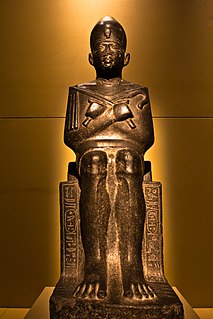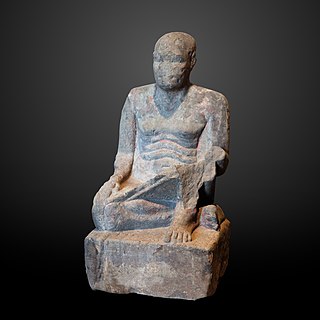
Amenemhat III, also known as Amenemhet III, was a pharaoh of ancient Egypt and the sixth king of the Twelfth Dynasty of the Middle Kingdom. He was elevated to throne as co-regent by his father Senusret III, with whom he shared the throne as the active king for twenty years. During his reign, Egypt attained its cultural and economic zenith of the Middle Kingdom.

The Middle Kingdom of Egypt is the period in the history of ancient Egypt following a period of political division known as the First Intermediate Period. The Middle Kingdom lasted from approximately 2040 to 1782 BC, stretching from the reunification of Egypt under the reign of Mentuhotep II in the Eleventh Dynasty to the end of the Twelfth Dynasty. The kings of the Eleventh Dynasty ruled from Thebes and the kings of the Twelfth Dynasty ruled from el-Lisht.

Pepi II Neferkare was a pharaoh of the Sixth Dynasty in Egypt's Old Kingdom who reigned from c. 2278 BC. His second name, Neferkare (Nefer-ka-Re), means "Beautiful is the Ka of Re". He succeeded to the throne at age six, after the death of Merenre I.

Sobekneferu or Neferusobek was a pharaoh of ancient Egypt and the last ruler of the Twelfth Dynasty of the Middle Kingdom. She ascended to the throne following the death of Amenemhat IV, possibly her brother and husband, though their relationship is unproven. Instead, she asserted legitimacy through her father Amenemhat III. Her reign lasted 3 years, 10 months, and 24 days, according to the Turin King List.

Amenemhat I, also known as Amenemhet I, was a pharaoh of ancient Egypt and the first king of the Twelfth Dynasty of the Middle Kingdom.

Senusret I also anglicized as Sesostris I and Senwosret I, was the second pharaoh of the Twelfth Dynasty of Egypt. He ruled from 1971 BC to 1926 BC, and was one of the most powerful kings of this Dynasty. He was the son of Amenemhat I. Senusret I was known by his prenomen, Kheperkare, which means "the Ka of Re is created." He expanded Egypt that allowed him to rule over an age of prosperity.

Khasekhemre Neferhotep I was an Egyptian pharaoh of the mid Thirteenth Dynasty ruling in the second half of the 18th century BC during a time referred to as the late Middle Kingdom or early Second Intermediate Period, depending on the scholar. One of the best attested rulers of the 13th Dynasty, Neferhotep I reigned for 11 years.

Khaneferre Sobekhotep IV was one of the more powerful Egyptian kings of the 13th Dynasty, who reigned at least eight years. His brothers, Neferhotep I and Sihathor, were his predecessors on the throne, the latter having only ruled as coregent for a few months.

Merhotepre Sobekhotep was an Egyptian king of the 13th Dynasty during the Second Intermediate Period. According to egyptologist Kim Ryholt he was the thirtieth pharaoh of the dynasty, while Darrell Baker believes instead that he was its twenty-ninth ruler. In older studies, Jürgen von Beckerath and Detlef Franke identified Merhotepre Sobekhotep with Merhotepre Ini, thereby making him Sobekhotep VI and the twenty-eighth ruler of the 13th Dynasty.

Khaankhre Sobekhotep was a pharaoh of the Thirteenth Dynasty of Egypt during the Second Intermediate Period.

Ankhu was an Egyptian vizier of the early 13th Dynasty, who lived around 1750 BC.
The Treasurer in Ancient Egypt is the modern translation of the title imi-r ḫtmt. The office is known since the end of the Old Kingdom, where people with this title appear sporadically in the organization of private estates.

Mentuhotep was an ancient Egyptian official and treasurer under the 12th Dynasty pharaoh Senusret I. Mentuhotep is one of the best attested officials of the Middle Kingdom period. There is a series of statues found at Karnak, showing him as a scribe. On these he has been given the title of overseer of all royal works, which would suggest that he was involved in overseeing the construction of the temple at Karnak. At el-Lisht he had a large tomb next to the pyramid of Senusret I. When it was found it was badly damaged, but there are remains of high quality reliefs and fragments of statues. The burial chamber still contained two sarcophagi, one smashed and the other one well preserved, made of granite and with brightly painted interiors.
This page list topics related to ancient Egypt.
Merkawre Sobekhotep was the thirty-seventh pharaoh of the Thirteenth Dynasty of Egypt during the Second Intermediate Period.

Menwadjre Sihathor was an ephemeral ruler of the 13th Dynasty during the late Middle Kingdom. Sihathor may never have enjoyed an independent reign, possibly only ruling for a few months as a coregent with his brother Neferhotep I. According to Egyptologist Kim Ryholt, Sihathor died in 1733 BC while Detlef Franke dates his short reign to 1694 BC. His tomb is likely to be the unfinished one located between the tombs of his brothers S9 and S10, in Abydos.

Sobekemsaf was an ancient Egyptian official of the Thirteenth Dynasty, around 1700 BC. He is especially well known from his statue in Vienna.
Khakau was the brother of King Sobekhotep III of the Thirteenth Dynasty and part of a powerful family taking power in a time of political turmoil in Upper Egypt. Although not of royal birth, he was given the title of "king's son" by his brother.
Dedusobek Bebi {ddw-sbk bbj} was a high official of the late Thirteenth Dynasty of ancient Egypt. He became the "Great Scribe of the Vizier" {ss wr n t3ty}. This position was directly under the Vizier acting as a deputy.
Rehuankh was an Ancient Egyptian high official during the reign of Neferhotep I of the Thirteenth Dynasty during the Middle Kingdom. Rehuankh is known from a high number of sources, making him one of the best attested officials of the late Middle Kingdom.














